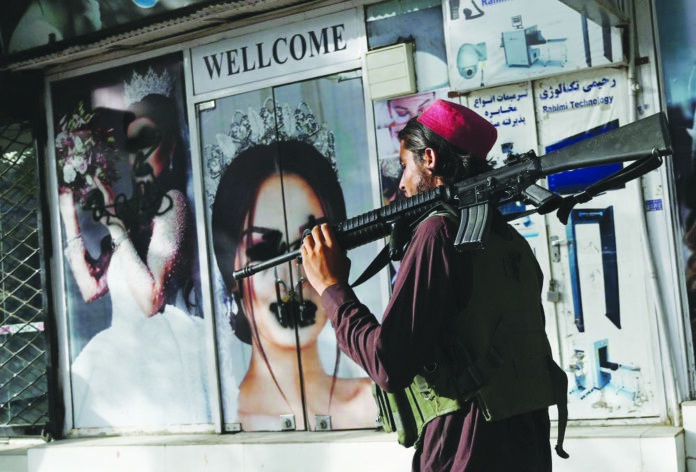The swift takeover of Afghanistan, and specifically its capital, Kabul, by the Taliban group has come as an immense shock and threat to nations all around the globe. Forty years of incessant foreign invasion, rule, and trillions of dollars’ worth investment by foreign powers got swept away in a matter of a few days. This is because the Afghan society has been absolutely ravaged by the continuous conflict it has, unfortunately, been a part of. In this context, the future of women’s rights is particularly a very important yet unpredictable topic of concern, not only for the women in Afghanistan, but also for the international community.
Western media and reports display the effective and pragmatic side of the so-called installed democracy, by the G-7 in Afghanistan, on women rights. Reports highlight the upsurge in women participation in parliamentary affairs in the US takeover compared to the Taliban regime of 1997-2001. Another prominent gain for Afghan women was the increased education enrollment percentage, which went as high as 40 percent for elementary school, 35 percent for middle and high school, and 33 percent for university. Apart from this, Afghan women made up 36 percent of the total workforce with women entrepreneurs creating 77,000 jobs for their female counterparts.
It is only the coming days that can truly unveil what prevails in Afghanistan and what does not. Though the Taliban have been reassuring of women’s freedom under their Islamic rule, there remains a widespread fear of the Taliban reinstalling their notorious gender segregation system that dominated the late 1990s
However, what the Western media fails to acknowledge is the harm this has done to Afghan society, and specially, females. Statistics from the United Nations show that the continuous NATO-Afghan war since 2001 has led to severe casualties for Afghan civilians. The extensive and increased use of Improvised Explosive Devices (IEDs) along with air and land strikes in the first half of the 21st century were the primary contributors to civilian casualties there. Girl children have been deliberately targeted at least on one occasion, the recent example of which is the 8th May attack outside the Sayed-ul-Shuhuda school in the district of Kabul. It is highly disturbing to notice 300 civilian victims with 85 killed due to this attack, out of which most were girls. May-June 2021 were particularly discomfiting months as increasingly women and children made up more of the civilian casualties recorded in Afghanistan.
According to recent UN reports, women and children, the explicit weak segments of society, accounted for 46 percent of the total casualties, including wounded and killed. A shocking and detrimental toll has been perpetuated by the years-long Afghan conflict, especially on children and women of all ages, amounting to extremely serious human rights’ violations.
The facts elucidated above give us something to ponder upon as the majority of the reports produced, news delivered and statistics maintained are straight from foreign UN sources, and not from any national source. Afghan women were perhaps not kept at the forefront as they were never invited to the decision-making table at any time in recent years even though they have always been willing to participate in the peace talks. These females constitute a prominent segment of society, and require that their rights are as recognized as of any other segment.
Moreover, as the Taliban have only recently assumed control of the country and are building up their power to fill in the power vacuum created by the absence of a national leader and the US forces, the socio-political paradigm has shifted. Though the Taliban announced the imposition of Islamic Shariah Law in their officially declared, Islamic Emirate of Afghanistan, they have vowed not to infringe women’s rights anyhow. They maintain they have learned from the mistakes of the past and so for the prosperity of the nation of Afghanistan, women will be permitted to educate themselves and to work within the realm of Islam.
Although most women believe to the contrary, a handful are affirmative about it. This is evident from the female journalists from BBC and CNN that we see giving media coverage to various events going on in the country without being mistreated, harmed or stopped. Indeed, they are in burka, but this portrays that the Taliban are respecting the Islamic dress code of women whilst allowing them to work, vote, and gain education peacefully too. It appears as if the past has served as a precept for the Taliban group, and now they seek to economically, socially and politically alleviate the conditions of the Afghan society, however, while staying within the boundaries prescribed by Islam.
The rights groups are apprehensive of women’s freedom being eroded away eventually under the Taliban regime as most women suspect them to not intending to honor the promises made. At the same time, even the staunchest women rights activists have acknowledged peace being made via negotiations with the Taliban, apart from which stands no other way for peace and amity to prevail.
Thus, it is only the coming days that can truly unveil what prevails in Afghanistan and what does not. Though the Taliban have been reassuring of women’s freedom under their Islamic rule, there remains a widespread fear of the Taliban reinstalling their notorious gender segregation system that dominated the late 1990s.























